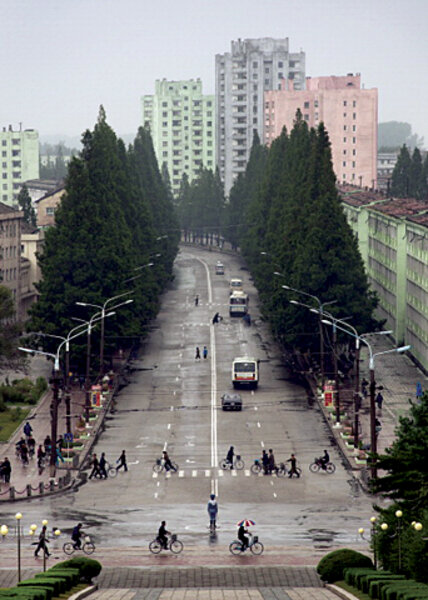In North Korea's industrial center, factories and wood-fueled trucks
Loading...
| Hamhung, North Korea
Our omnipresent guide advises, "This city is not used to foreigners, so please: no pictures."
That peremptory order introduces us to North Korea's biggest industrial center, a dreary city of 800,000 near the eastern coast about 100 miles northeast of Pyongyang. It's not certain, however, if the sensitivity reflects chagrin over the decrepit apartment blocks and the graying industrial zone or concerns about how the locals, who have rarely seen foreigners, will respond.
"This city was opened just two years ago," the guide says, and it's believed to harbor many tales of poverty and starvation from the darkest days of the 1990s famine when 2 million people died throughout the country.
The hardships endured by many here, according to foreign aid workers who visit occasionally, contrasted with the privileges of officials and their cronies and relatives, with close enough ties to authorities in Pyongyang to get enough food and medicine.
The coastal road leading to the city gives a sense of the difficulties. It's a bumpy ride down a two-lane highway in serious need of repair; few vehicles are in sight. The scene is deceptively bucolic – a picture of how the countryside might have appeared a century ago.
The only blemish on the tranquil image is the black smoke spewing from trucks powered not by gas but by wood in stoves mounted in the open rear cargo sections. Guides ban photo-graphs of these old wood-burners – a colorful tribute to ingenuity in a time of need but an embarrassment to a country that looks more like a backward third-world enclave than a regional power player.
There is, however, no hiding the poverty of a region where oxen pull carts and plows and most people ride or push bicycles.
We see corn and vegetables growing up to the walls of small cement homes. Families have come to depend on private plots to supplement harvests from cooperative farms that don't leave enough for the farmers, who are supposed to get a small percentage of what they grow. It's out of the question, though, to talk to anyone about life on the farm.
Instead, we're taken to a "showcase cooperative" – a collective farm that's deemed fit for foreign visitors to see. A monument memorializes a visit by "eternal president" Kim Il-sung, who died in 1994, and children sing for us in a schoolyard.
The farmers are mostly out of view, in distant fields, but the home of one of them, three or four neat rooms, including a small kitchen, is open for a carefully monitored visit.
In the industrial area of the city, a narrow-gauge railway dating from the Japanese colonial era runs alongside mostly empty streets. It was created to carry workers to factories built soon after the Korean War. We're told it carries workers to factories built soon after the Korean War, but no trains are moving.
Moving past factories in our tour bus we're again told not to photograph anything, including a sprawling plant that produces vinylon, a fabric made from limestone that is uniquely North Korean.
Deep in the complex, another factory is said to produce "machinery," but the absence of people and darkened factory walls are reminders of the failure to emerge from the trauma of the Korean War followed by years of economic mismanagement.
A showcase fertilizer factory, however, is on the itinerary. Modern machinery glistens – testimony to the potential for other factories. "All this equipment we made by ourselves," says Lim Hung-nam, the factory's manager.
He says the factory operates at full capacity for two shifts, producing 700,000 tons a year. Another factory on the west coast produces 600,000 tons, he says, but the country still imports fertilizer from China, since South Korean President Lee Myung-bak cut off almost all aid after his inauguration in early 2008.
Asked whether Kim Il-sung or Kim Jong-il ever visited, Mr. Lim quickly points to two bronze tablets near the entrance. Their inscriptions testify to appearances from both, in which they offered "on-the-spot guidance."
Back at the city's only hotel for foreigners, a team of doctors from the International Red Cross has just returned from a hospital visit. Someone asks a British doctor what to do in case of a medical emergency.
His response is quick and unequivocal: "Get on a plane and leave the country."






